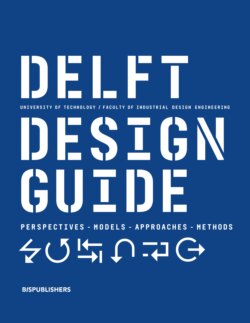Читать книгу Delft Design Guide -Revised edition - Annemiek van Boeijen - Страница 32
На сайте Литреса книга снята с продажи.
ОглавлениеWhat & Why? Speculative Design uses the future as a backdrop for engaging with social dilemmas, and it allows designers to break free from some of the cognitive, normative, and behavioural constraints of the present. This method creates an imaginative space for designers to consider and convey the consequences of contemporary and future ways of being. Speculative Design can be seen as a form of communication – it invites users to reflect and debate matters of concern, perform the future situation or ‘try it on for size’, and discover alternatives to current conditions.
The imaginative nature and future orientation of Speculative Design make it es- pecially suitable for engaging with complex and even ‘wicked’ problems. Such prob- lems often display a puzzling array of emergent, interrelated causes and dynamics, and therefore they do not lend themselves to traditional forms of problem solving by design. Speculative Design allows designers to inquire about the various dimensions of the problem without attempting to solve it outright, thus opening up the problem space to new perspectives.
------------------------------------------------------------------------------------------------------------------
Mindset: Speculative Design operates on multiple temporalities, thereby suggesting alternative pasts, presents, or futures. To do this effectively, both designers and users are asked to suspend disbelief in the designed outcome. This involves replacing plausibility: ‘Will this come true in the future?’ , with credibility: ‘Does it feel like this future could come true?’ as a criterion for evaluating outcomes. Reference to a real world ‘out there’ is substituted for a sense of internal – or diegetic – consistency.
------------------------------------------------------------------------------------------------------------------
How? Speculative Design processes often start by projecting the current social, cultural, and technological trends into the future. Future possibilities are then crafted into provocative, imaginative scenarios, and these scenarios can be materialised through a variety of design tools, tech- niques, and media.
While there is no single ‘standard’ or conventional way to conduct Speculative Design, most speculative designers make use of techniques drawn from futures studies (or futurology). These techniques
include Trend Foresight and Horizon Scanning, but also more commonly Written Scenarios, which consists of positing ‘what if’ questions and following them to their logical conclusions (see Trend Foresight and Written Scenarios). Pluralizing the future in this way may lead to unanticipated, evocative results.
Since Speculative Design often pro- ceeds as a form of storytelling, it makes use of fictionalizing techniques. These are meant to create compelling narratives and situations that are credible yet provocative.
Speculative Design
References & Further Reading: Dunne, A., & Raby, F., 2013. Speculative everything: design, fiction, and social dreaming. Cambridge, Mass.: MIT Press. / Wakkary, R., Odom, W., Hauser, S., Hertz, G., & Lin, H., 2015. Material Speculation: Actual Artifacts for Critical Inquiry. Aarhus Series on Human Centered Computing , 1(1), 97-108. / Wilkie, A., Savransky, M., & Rosengarten, M. (Eds.)., 2017. Speculative Research: The Lure of Possible Futures. Abingdon, UK; New York: Routledge. / Bendor, R., van der Helm, A., & Jaskiewicz, T. (Eds.)., 2018. A Spectrum of Possibilities: A Catalog of Tools for Urban Citizenship in the Not-So-Far Future. Delft: Faculty of Industrial Design Engineering, Delft University of Technology.
Tips & Concerns
The significance lies in provoking the imagination and the sense of possibility in both the designer and the user.
--------
Speculative Design should not be confused with other future-oriented design techniques such as Design Fiction in particular, which can be seen as ways to prepare for the future instead of illustrating the future’s malleability.
--------
The construction of thought- provoking situations often works well with more nuanced rhetorical strategies such as humour, irony, and grotesque exaggeration.
--------
Create a sense of personal relevance and affect while maintaining a critical distance from the design itself.
------------------------------------------
Limitations
The success of Speculative Design processes relies on the fit between the chosen scenario, including its time-frame, cultural context, and protagonists. And the user’s interpretive strategies, such as their existing social imaginaries, cultural tropes, and background.
--------
It is important to remember that the outcome may feel more like fanciful fantasy than critical speculation if the designed outcome is situated too far into the future, if the situation lacks credibility, or if the interaction lacks consistency.
Speculative Design seeks to create and promote critical discourse around important social issues. By giving future possibilities a provocative and tangible form, designers attempt to disclose and challenge our social imaginaries. Speculating about the future using this mode can serve as a means to problematize our current conditions and contemplate future alternatives.
perspectives
---------------------------------------------------------------------------------------------------------------------------------------------------------------
31
